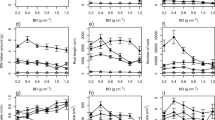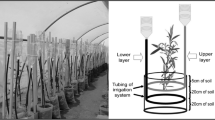Abstract
Soil conditions of mangrove forests in southern Japan were found to correlate largely with zonal distributions of the species.Kandelia candel grew in soils with low salinity and low pH,Avicennia marina, Rhizophora stylosa andSonneratia alba in soils with high salinity and high pH, andBruguiera gymnorrhiza in soil with a wide range of pH but limited range of salinity.Lumnitzera racemosa colonized soil with a wide range of pH and medium salinity. Seedlings ofKandelia candel, Bruguiera gymnorrhiza andRhizophora stylosa were planted in soils with differing salinity and pH. Optimum seedling growth ofKandelia, Bruguiera andRhizophora occurred when plants were cultivated in soils similar to those of their natural habitats, suggesting that growth of mangrove species and their zonal distributions were regulated by salinity and soil pH.
Similar content being viewed by others
References
Burchett, M.D., Field, C.D. andPulkownik, A. 1984. Safinity, growth and root respiration in the grey mangrove,Avicennia marina. Physiol. Plant.60: 113–118.
Chapman, V.J. 1976. Mangrove vegetation. J. Cramer. 447 pp.
Clarke, L.D. andHannon, N.J. 1967. The mangrove swamp and salt marsh communities of the Sydney district, 1. Vegetation, soils and climate. J. Ecol.55: 753–771
Clarke, L.D. andHannon, N.J. 1970. The mangrove swamp and salt marsh communities of the Sydney district, Ill. Plant growth in relation to salinity and waterlogging. J. Ecol.58: 351–369.
Donahue, R.L., Miller, R.W. andSchickluna, S.C. 1985. An Introduction to soils and plant growth, Prentice-Hall, Inc., Engelwood Cliffs, New Jersey.
Downton, W.J.S. 1982. Growth and osmotic relations of the mangroveAvicennia marina, as influenced by salinity. Aust. J. Plant Physiol.9: 519–528
Galloway, R.W. 1982. Distribution and physiographic pattern of Australian mangroves. Mangrove ecosystem in Australia, structure, function and management (eds. B. F. Clough) pp. 31–54. Australian National University Press, Canberra.
Gredhill, D. 1963. The ecology of the Aberdeen creek mangrove swamp. Journal of Botany52: 693–703.
Kikuchi, T., Tamura, T., Makita, H. andMiyagi, T. 1978. Arrangement of swamp forests and landform of the alluvial plain in the lower Nakama River, Iriomote Island, Ryukyu Archipelago, Japan, 1. Mangrove Swamp. Annual of Tohoku Geographycal Association30: 71–81.
Kuraishi, S., Kojima, K., Miyauchi, H., Sakurai, N., Tsubota, H., Ninaki, N., Goto, I. andSugi, J. 1985. Brackishwater and soil components of mangrove forests on Iriomote Island, Japan. Biotropica13: 277–286
Lugo, A.E. andSnedaker, S.C. 1974. The ecology of mangroves. Ann. Rev. Ecol. System.5: 39–64.
Miyata, I. andOdani, N. 1963. Vegetation in Iriomote Is., Yaeyama Islands. Japanese Report for Communication of Foreign Science Research, Kyushu University1: 23–42.
Miyawaki, A., Suzuki, K., Suzuki, S., Nakamura, Y., Murakami, Y., Tukagoshi, Y. andNakata, E. 1983. Pflanzensoziologische Untersuchung der Mangrove Vegetation in Japan. 1. Mangrove Vegetation auf der Iriomote-Insel. Bulletin of Institute of Environmental Science of Technology, Yokohama National University9: 77–89.
Nakasuga, T. 1983. Salinity and hydrogen exponent of environmental water on mangrove forest, and osmotic pressure ofKandelia candel. The Sub-Tropical Forest Association5: 68–79.
Nakasuga, T., Oyama, H. andHaruki, M. 1974. Studies on the mangrove community. 1. Distribution of the mangrove community in Japan. J. Jap. Ecol.24: 237–246.
Rao, C.R. 1973. Linear Statistical Inference and its Applications. 2nd. edn., John Wiley and Sons. 625 pp.
Rika Nenpyo 1989. Chronological Scientific Tables. (edn. Tokyo Astronomical Observatory) 678 pp, 1007. Maruzen Co. Ltd., Tokyo.
Spenceley, A.P. 1983. Aspects of the development of mangals in the Townsville Region, North Queensland, Australia.In H.J. Teas, ed., Biology and ecology of mangroves. Tasks for vegetation science 8, The Hague, Junk.
Takeshita Y. andNoguchi, H. 1974. Mangroves grown at Minami-Izu, Japan. J. Jap. Soc. Bot. Gard.9: 7–14.
Thon, B.G. 1967. Mangrove ecology and deltaic geomorphology, Tobasco, Mexico. J. Ecol.55: 301–343.
Tomlinson, P.B. 1986. The Botany of Mangroves. Cambridge tropical biology series. 413 pp.
Troll, W. andDrangendorff, O. 1931. Uber die Lufwurzern vonSonneratia L. und ihre Biologische Bedeutung. Planta13: 311–373.
Author information
Authors and Affiliations
Rights and permissions
About this article
Cite this article
Wakushima, S., Kuraishi, S. & Sakurai, N. Soil salinity and pH in Japanese mangrove forests and growth of cultivated mangrove plants in different soil conditions. J. Plant Res. 107, 39–46 (1994). https://doi.org/10.1007/BF02344528
Received:
Accepted:
Issue Date:
DOI: https://doi.org/10.1007/BF02344528




